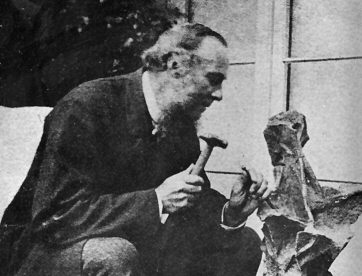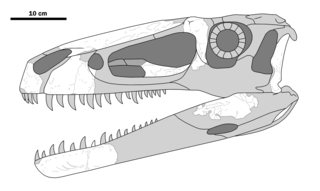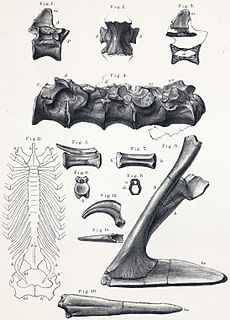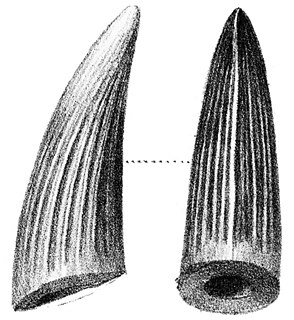Related Research Articles
Loxaulax is a genus of extinct mammal from the Lower Cretaceous of southern England. It was a member of the also extinct order Multituberculata, and lived alongside the dinosaurs. It lies within the suborder "Plagiaulacida" and family Eobaataridae. The genus Loxaulax was named by Simpson G.G. in 1928 based on one species.

Dinosaur Isle is a purpose-built dinosaur museum located in Sandown on the Isle of Wight in southern England.

Baryonyx is a genus of theropod dinosaur which lived in the Barremian stage of the Early Cretaceous period, about 130–125 million years ago. The first skeleton was discovered in 1983 in the Weald Clay Formation of Surrey, England, and became the holotype specimen of Baryonyx walkeri, named by palaeontologists Alan J. Charig and Angela C. Milner in 1986. The generic name, Baryonyx, means "heavy claw" and alludes to the animal's very large claw on the first finger; the specific name, walkeri, refers to its discoverer, amateur fossil collector William J. Walker. The holotype specimen is one of the most complete theropod skeletons from the UK, and its discovery attracted media attention. Specimens later discovered in other parts of the United Kingdom and Iberia have also been assigned to the genus.

Hylaeosaurus is a herbivorous ankylosaurian dinosaur that lived about 136 million years ago, in the late Valanginian stage of the early Cretaceous period of England.
The Isle of Wight is one of the richest dinosaur localities in Europe, with over 20 species of dinosaur having been recognised from the early Cretaceous Period, some of which were first identified on the island, as well as the contemporary non-dinosaurian species of crocodile, turtle and pterosaur.

Polacanthus, deriving its name from the Ancient Greek polys-/πολύς- "many" and akantha/ἄκανθα "thorn" or "prickle", is an early armoured, spiked, plant-eating ankylosaurian dinosaur from the early Cretaceous period of England.

William D. Fox was an English clergyman and palaeontologist who worked on the Isle of Wight and made some significant discoveries of dinosaur fossils.

Neovenator (nee-o-ven-a-tor), which means "new hunter", is a genus of neovenatorid dinosaur. At the time of its discovery on the Isle of Wight, United Kingdom, it was the best-known large carnivorous dinosaur from the Early Cretaceous period of what is now Europe.

Eotyrannus is a genus of tyrannosauroid theropod dinosaur hailing from the Early Cretaceous Wessex Formation beds, included in Wealden Group, located in the southwest coast of the Isle of Wight, United Kingdom. The remains (MIWG1997.550), consisting of assorted skull, axial skeleton and appendicular skeleton elements, from a juvenile or subadult, found in a plant debris clay bed, were described by Hutt et al. in early 2001. The etymology of the generic name refers to the animals classification as an early tyrannosaur or "tyrant lizard", while the specific name honors the discoverer of the fossil.

Dr. Darren Naish is a British vertebrate palaeontologist, author and science communicator. As a researcher, he is best known for his work describing and reevaluating dinosaurs and other Mesozoic reptiles, including Eotyrannus, Xenoposeidon, and Azhdarchid pterosaurs. Much of his research has focused on Wealden Group fossils from the Isle of Wight. He is founder of the vertebrate palaeozoology blog Tetrapod Zoology, and has written several popular science books. Naish also makes frequent media appearances and is a scientific consultant and advisor for film, television, museums and exhibitions. Naish is also known for his skepticism and work examining cryptozoology and sea monster sightings and beliefs from a scientific perspective.

Aristosuchus is a genus of small coelurosaurian dinosaur whose name was derived from the Greek ἄριστος and σουχος. It shared many characteristics with birds.

Oplosaurus was a genus of sauropod dinosaur from the Barremian-age Lower Cretaceous Wessex Formation of the Isle of Wight, England. It is known from a single tooth usually referred to the contemporaneous "wastebasket taxon" Pelorosaurus, although there is no solid evidence for this.

Atherfield is a rural location in the south west of the Isle of Wight, UK. It includes the small settlements of Atherfield Green and Little Atherfield, as well as several farms, and is set in largely open farmland. To the south west it is bounded by the cliffs of Chale Bay and Brighstone Bay, which are divided by Atherfield Point. The south-eastern part of Brighstone Bay is also sometimes known as Atherfield Bay, and was the site of a former holiday camp, now demolished.

Mantellisaurus is a genus of iguanodontian dinosaur that lived in the Barremian and early Aptian ages of the Early Cretaceous Period of Europe. Its remains are known from Belgium (Bernissart), England, Spain and Germany. The type and only species is M. atherfieldensis. Formerly known as Iguanodon atherfieldensis, the new genus Mantellisaurus was erected for the species by Gregory Paul in 2007. According to Paul, Mantellisaurus was more lightly built than Iguanodon and more closely related to Ouranosaurus, making Iguanodon in its traditional sense paraphyletic. It is known from many complete and almost complete skeletons. The genus name honours Gideon Mantell, the discoverer of Iguanodon.

Istiodactylus is a genus of pterosaur that lived during the Early Cretaceous period, about 120 million years ago. The first fossil was discovered on the English Isle of Wight in 1887, and in 1901 became the holotype specimen of a new species, O. latidens, in the genus Ornithodesmus. This species was moved to its own genus, Istiodactylus, in 2001; this name is Greek for "sail finger". More specimens were described in 1913, and Istiodactylus was the only pterosaur known from three-dimensionally preserved fossils for much of the 20th century. In 2006, a species from China, I. sinensis, was assigned to Istiodactylus, but it has also been suggested to belong to a different genus.

Suchosaurus is a spinosaurid dinosaur from Cretaceous England and Portugal, originally believed to be a genus of crocodile. The type material, consisting of teeth, was used by British palaeontologist Richard Owen to name the species S. cultridens in 1841. Later in 1897, French palaeontologist Henri-Émile Sauvage named a second species, S. girardi, based on two fragments from the mandible and one tooth discovered in Portugal. Suchosaurus is possibly a senior synonym of the contemporary spinosaurid Baryonyx, but is usually considered a dubious name due to the paucity of its remains. In the Wadhurst Clay Formation of what is now southern England, Suchosaurus lived alongside other dinosaurs, as well as plesiosaurs, mammals, and crocodyliforms.

The Wessex Formation is a fossil-rich English geological formation that dates from the Berriasian to Barremian stages of the Early Cretaceous. It forms part of the Wealden Group and underlies the younger Vectis Formation and overlies the Durlston Formation. The dominant lithology of this unit is mudstone with some interbedded sandstones. It is exposed in both the Isle of Purbeck and the Isle of Wight. While the Purbeck sections are largely barren of vertebrate remains, the Isle of Wight sections are well known for producing the richest and most diverse fauna in Early Cretaceous Europe. Regional correlations include the Upper Weald Clay of the United Kingdom, the Sainte-Barbe Clays Formation of Belgium, and the La Huérguina and Camarillas Formations of Spain.

The Vectis Formation is a geological formation on the Isle of Wight and Swanage, England whose strata were formed in the lowermost Aptian, approximately 125 million years ago. The environment of deposition was that of a freshwater coastal lagoon with occasional marine influence after the early Aptian marine transgression, transitioning from the floodplain environment of the underlying Wessex Formation. The primary lithology is of laminated grey mudstones. The Vectis Formation is composed of three geological members: the Shepherds Chine member, the Barnes High Sandstone member, and the Cowleaze Chine member. It is overlain by the fully marine Atherfield Clay Formation, part of the Lower Greensand Group. Dinosaur remains are among the fossils that have been recovered from the formation.

Vectidraco, is a genus of azhdarchoid pterosaur from the Lower Cretaceous of England.

Koumpiodontosuchus is an extinct genus of neosuchian crocodyliform that lived in the Early Cretaceous. The only species is K. aprosdokiti, named in 2015.
References
- ↑ Simpson, M. I. (1985). "The stratigraphy of the Atherfield Clay Formation (Lower Aptian, Lower Cretaceous) at the type and other localities in southern England". Proceedings of the Geologists' Association. doi:10.1016/s0016-7878(85)80012-2.
- ↑ John Windsor (1994-10-02). "Article on Polacanthus discovery". The Independent . Retrieved 2009-10-17.